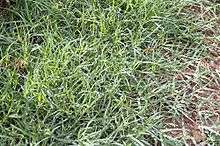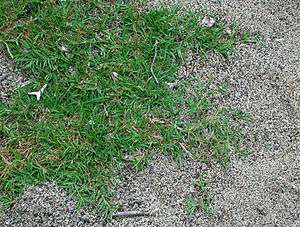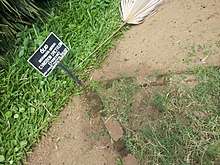Cynodon dactylon
Cynodon dactylon, known as Bermuda grass, Dhoob, dūrvā grass, ethana grass,dubo, dog's tooth grass,[2] Bahama grass, devil's grass, couch grass, Indian doab, arugampul, grama, wiregrass and scutch grass, is a grass that is native to most of the eastern hemisphere.[3][4] Although it is not native to Bermuda, it is an abundant invasive species there. In Bermuda it has been known as crab grass (also a name for Digitaria sanguinalis).
| Cynodon dactylon | |
|---|---|
 | |
| Scientific classification | |
| Kingdom: | Plantae |
| Clade: | Tracheophytes |
| Clade: | Angiosperms |
| Clade: | Monocots |
| Clade: | Commelinids |
| Order: | Poales |
| Family: | Poaceae |
| Genus: | Cynodon |
| Species: | C. dactylon |
| Binomial name | |
| Cynodon dactylon (L.) Pers. | |
| Synonyms[1] | |
|
List
| |
Description

The blades are a grey-green colour and are short, usually 2–15 cm (0.79–5.91 in) long with rough edges.[5] The erect stems can grow 1–30 cm (0.39–11.81 in) tall. The stems are slightly flattened, often tinged purple in colour.
The seed heads are produced in a cluster of two to six spikes together at the top of the stem, each spike 2–5 cm (0.79–1.97 in) long.[5]
It has a deep root system; in drought situations with penetrable soil, the root system can grow to over 2 metres (6.6 ft) deep, though most of the root mass is less than 60 centimetres (24 in) under the surface. The grass creeps along the ground with its stolons and roots wherever a node touches the ground, forming a dense mat. C. dactylon reproduces through seeds, stolons, and rhizomes. Growth begins at temperatures above 15 °C (59 °F) with optimum growth between 24 and 37 °C (75 and 99 °F); in winter, the grass becomes dormant and turns brown. Growth is promoted by full sun and retarded by full shade, e.g., close to tree trunks.
Cultivation
Cynodon dactylon is widely cultivated in warm climates all over the world between about 30° S and 30° N latitude, and that get between 625 and 1,750 mm (24.6 and 68.9 in) of rainfall a year (or less, if irrigation is available). It is also found in the U.S., mostly in the southern half of the country and in warm climates. Detailed study using experimental animals exhibited anti-stress, adaptogenic activities and improved male fertility.[6]
Uses
Religious
In India, commonly known as "durva" or dūrvāyugma, this grass is used in the Ayurveda system of medicine. In Hinduism, it is considered important in the worship of Lord Ganesha. It has been a part of Hindu rituals since Vedic times.
A unique festival, called Durva Ashtami, dedicated to the grass is celebrated on the 8th day of Shukla Paksha of Bhadra month of the Hindu calendar.[9]
This grass is a Yoruba herb used for Esu or Elegba in the Ifa Orisa System.
Medicinal value
Cynodon dactylon has shown significant effects against intestinal helminth infections in rodents Yadav and Nath: Intercult Ethnopharmacol, 6).
Other
It is fast-growing and tough, making it popular and useful for sports fields, as when damaged it will recover quickly. It is a highly desirable turf grass in warm temperate climates, particularly for those regions where its heat and drought tolerance enable it to survive where few other grasses do. This combination makes it a frequent choice for golf courses in the southern and southeastern U.S. It has a relatively coarse-bladed form with numerous cultivars selected for different turf requirements.
Bermuda grass has been cultivated in saline soils in California's Central Valley, which are too salt-damaged to support agricultural crops; it was successfully irrigated with saline water and used to graze cattle.[10][11]
Ecology

Invasive species
It is a highly aggressive invasive species, crowding out most other grasses and invading other habitats, and has become a hard-to-eradicate weed in some areas (it can be controlled somewhat with Triclopyr, Mesotrione, Fluazifop-P-butyl, and Glyphosate).[12][13] This weedy nature leads some gardeners to give it the name of "devil grass". Bermuda grass is incredibly difficult to control in flower beds and most herbicides do not work. However, Ornamec, Ornamec 170, Turflon ester (tricyclopyr), and Imazapyr have shown some effectiveness. All of these items are difficult to find in retail stores, as they are primarily marketed to professional landscapers.[14]
The hybrid variety Tifton 85, like some other grasses (e.g. sorghum), produces cyanide under certain conditions,[15] and has been implicated in several livestock deaths (note that in several places this variety has been incorrectly reported as a genetically modified strain;[16] actually it is a conventionally bred F1 hybrid[17]).
References
- "The Plant List: A Working List of All Plant Species".
- "Iraq". lntreasures.com. Retrieved 5 November 2015.
- "Cynodon dactylon (L.) Pers. | Plants of the World Online | Kew Science".
- "CABI Invasive Species Compendium".
- Walker, Karen; Burrows, Geoff; McMahon, Lynne (2001). Bidgee bush: an identification guide to common native plant species of the south western slopes of New South Wales. Yarralumla, Australian Capital Territory: Greening Australia. p. 82. ISBN 978-1-875345-61-8. Retrieved 21 March 2010.
- VR Chidrawar, HR Chitme, KN Patel, NJ Patel, VR Racharla, NC Dhoraji, KR Vadalia, Journal of Young Pharmacists, 2011, 3(1), 26-35
- Shi H, Wang Y, Cheng Z, Ye T, Chan Z. Analysis of natural variation in bermuda grass (Cynodon dactylon) reveals physiological responses underlying drought tolerance. PLoS ONE. 2012;7(12):e53422.
- "Warm-Season Grass Breeding". www.uga.edu. Retrieved 2017-09-13.
- Majupuria, Trilok Chandra (2009). Religious & useful plants of Nepal & India: (medicinal plants and flowers as mentioned in religious myths and legends of Hinduism and Buddhism). Rohit Kumar (Majupuria). ISBN 978-9937-2-0473-6.
- Kaffka, Stephen (2009). "Can feedstock production for biofuels be sustainable in California?" (PDF). California Agriculture. 63 (4): 202–207. doi:10.3733/ca.v063n04p202. Archived from the original (PDF) on 2017-08-13. Retrieved 2013-06-09.
- Stephen Kaffka; Stephen Grattan; Dennis Corwi; Maximo Alonso; George E. Brown Jr. "Bermuda Grass Yield and Quality in Response to Different Salinity and N, Se, Mo, and B Rates in West San Joaquin Valley" (PDF). UC Center for Water Resources.
- "Tenacity and Bermuda Control - LawnSite.com™ - Lawn Care & Landscaping Business Forum". Lawnsite.com. 2011. Retrieved 2013-06-08.
- Teuton T.C.; J.B. Unruh; B.J. Brecke; G.L. Miller (2005). "Hybrid Bermudagrass (Cynodon dactylon (L) Pers. x C. transvaalensis Burtt-Davy) Control with Glyphosate and Fluazifop-p-butyl". Applied Turfgrass Science. doi:10.1094/ATS-2005-0119-01-RS. Archived from the original on 2011-03-21.
- John Boyd; Brian N. Rodgers. "BERMUDAGRASS CONTROL WITH ARSENAL" (PDF). Archived from the original (PDF) on 9 June 2010.
- Provin, T. L.; Pitt, J. L. "Nitrates and Prussic Acid in Forages" (PDF). Texas A&M University System. Retrieved June 24, 2012.
- CBS News (June 23, 2012). "GM grass linked to Texas cattle deaths". CBS News. Retrieved June 24, 2012.
- Glenn W. Burton; Roger N. Gates; Gary M. Hill. "TIFTON 85 BERMUDAGRASS". University of Georgia College of Agricultural and Environmental Sciences. Retrieved June 24, 2012.